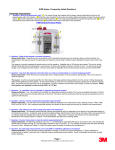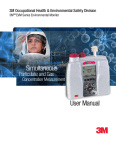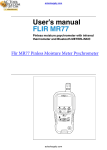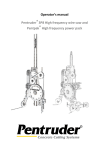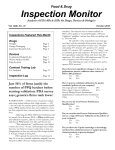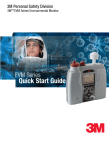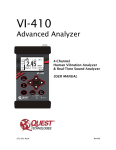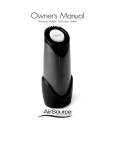Download EVM Series: Frequently Asked Questions
Transcript
EVM Series: Frequently Asked Questions Particulate measurements 1. Question: For particulate measurements, how is the EVM7 and EVM3 calibrated in the factory? Response/Solution: Each instrument is factory calibrated to the ISO 12103A2 Fine (Arizona Road Dust). A factory calibration is conducted with a “golden” instrument that is calibrated using a certifiable gravimetric sample. Quest Technologies recommends a yearly factory calibration. 2. Question: Do I need to calibrate before I run realtime particulate measurements? Response/Solution: Yes, it is recommended to perform a zero calibration in each environment you will be measuring particulates. To perform a zero calibration, ensure that the zero filter/HEPA filter is attached, the impactor is well greased, and the turret is set to PM. Then, using the keypad navigate to Calibrate>PM screen and perform a zero calibration. (Please see Chapter 4 of the EVM Series User Manual for specific details.) NOTE: a zero calibration may be used when performing areasurvey monitoring. However, if you are testing in accordance to NIOSH0600 or if you want to measure the actual mass concentration in a specific environment, you would run a gravimetric calibration to determine a correction factor referenced to the ARD. 3. Question: When test collecting realtime particulate measurements for a period of time, how do I verify the calibration? Response/Solution: First, ensure you performed a zero calibration prior to your testing (with the supplied Zero/HEPA filter). Run your realtime particulate measurements. Then, perform a Calibration (PM) Verify via the Verify softkey/quick key. (Please see Chapter 4 of the EVM series user manual for specific details.) 4. Question: What if I need to calibrate particulates in accordance to NIOSH0600? Response/Solution: A gravimetric calibration is performed. The steps below outline a gravimetric calibration. (Please see Chapter 4 of the EVM Series User Manual for specific details.) 1. Reset the gravimetric and volume accumulators. 2. Insert a new (sealed) gravimetric cassette. 3. Measure in the specific location for approximately four to eight hours. 4. Proceeding the measurement, the gravimetric accumulator on the EVM will display the amount of dust that has accumulated based on the active profile. (This value is used in conjunction with the weight of the measured dust in the cassette.) 5. To determine the weight of particulates in the gravimetric filter, remove the gravimetric cassette and weigh the contents. (Typically, sent to a lab for results.) Do not include the weight of the cassette. 6. To determine the correction factor, calculate the ratio between the particulate mass value and the weight from the gravimetric filter lab analysis. For example, let’s say that you measured for 8 hours in a wood shop and the PM mass accumulator displays 10 mg. You then measured the dust in the gravimetric filter/cassette and determined the weight as 20 mg. To calculate the correction factor, divide 20 mg by 10 mg and your value is 2. The correction factor of “2” is multiplied by the existing active profile correction factor, and is entered as the new correction factor (Setup\PM\EDIT PROFILE). 5. Question: How many correction factors can be stored on the monitor and in QSPII? Response/Solution: The EVM supports 8 different particulate matter (PM) configurations/profiles with customized name settings and user correction factor settings. See Chapter 3 for instrument profile setup or Chapter 6 for QSPII setup of the EVM Series user Manual for more details. 6. Question: What if I want to enter in the correction factor after running/logging particulate measurements? Response/Solution: You can adjust/change the correction factor in QuestSuite Professional II after the session has been downloaded. The Dust Correction Override feature is a type of scaling factor that will recalculate the data instantly in the chart or graph you are viewing. (NOTE: the Dust Correction Override field is displayed in the General Data panel and is applied to the dust measurements in the logged data chart/table when dust is the selected parameter. To apply, select the dust override icon and add a new value.) EVM Series: Frequently Asked Questions 7. Question: What do the impactor cutpoints represent? Response/Solution: Depending on the environment and the industrial processes (such as sanding, cutting, crushing, grinding, and transportation), the type and size of the particulates will impact the human body in different areas, affecting the nasal, throat, and/or lung area. The impactor cutpoints represent the particle size you will be sampling. Inhalable dust is 100 microns and smaller. This dust is usually filtered through the hairs and membranes in your sinuses. 10 microns and smaller is thoracic, and dust in the 4 10 micron size can get caught in you windpipe and other regions. 4 microns and smaller is respirable and this is what causes concerns and the need for PM4. 8. Question: Is it possible to do an inhalable or respirable gravimetric sample? Response/Solution: Yes, it is possible to do inhalable and respirable gravimetric sampling. This can be accomplished through the "dialin" impactors or with a cyclone in the open (4th) hole on the turret. This hole is used for zeroing the instrument as well as allowing the use of a cyclone in that inlet port. 9. Question: How do I set the cutpoints for particulate measurements? Response/Solution: Turn the turret until the appropriate setting is displayed on the instrument’s screen. (Settings include: PM2.5, PM4, PM10, and PM/TSP.) 10. Question: How often do you need to apply the grease to the impactors? Response/Solution: The impactors will also require periodic cleaning (and greasing) which is dependent on the density of air particulates floating in the intended environment. A relatively dusty environment (approximately under10mg/m3) should last an entire day. When dust pyramids form on impactor plates this signifies they require cleaning and greasing. Please refer to Impactor Care Section and the Optical Engine Maintenance and Cleaning Section in Chapter 7 of the EVM Series User Manual for cleaning details. Particulate measurements 11. Question: How do I know when to clean the optical engine/photometer? Response/Solution: The following conditions may occur: (1) If calibrating the particulate (PM) sensor and it will not zero, this indicates the optical engine will need cleaning. (2) The instrument is exposed to oily or wet mists. (3) The readings are falling lower and lower indicating the mirror is dirty. (Please see Chapter 7 of the EVM series manual for details on cleaning and maintenance.) Gravimetric Sample (optional for particulate calibration) 1. Question: What is the backpressure capabilities? (inches/water column) Response/Solution: >= 15 inches of water @ 1.67 LPM 2. Question: What type of cassette can be installed other than 37mm? Response/Solution: Both 25mm and 37mm cassettes can be used in the EVM monitor. 3. Question: Can we run the unit without a cassette? Response/Solution: The monitor should not be run without a cassette. The monitor is installed with a pump protection filter cassette. As its name indicates, it protects the pump from particulate matter. This cassette or a new cassette (if performing a gravimetric sample) should always be installed. It should be noted that the pump protection filter cassette will periodically need to be cleaned or replaced. 4. Question: Does Quest offer cassettes? Response/Solution: Quest Technologies offers a 5pack of 37mm gravimetric cassettes (for pump protection). Order Part Number 0740765. Quest Technologies also offers a 10pack, order Part Number 074090. EVM Series: Frequently Asked Questions Toxic Sensor measurements 1. Question: How many toxics can I measure simultaneously? Response/Solution: One toxic sensor (which is located in the left position of the housing). 2. Question: What’s the life expectancy and warranty on the various Sensors? Response: Sensor Type Life expectancy Particulates sensor 5000 hours (for the laser photometer) CO2 sensor 5 years PID sensor (for measuring VOC’s) 2000 hours in clean air environment (replaceable bulb and grid) Carbon Monoxide (CO) Chlorine (CL2) Ethylene Oxide (EtO) Hydrogen Cyanide (HCN) Hydrogen Sulfide (H2S) Nitrogen Dioxide (NO2) Nitric Oxide (NO) Oxygen (O2) Sulphur Dioxide (SO2) 2 years 2 years 2 years 2 years 2 years 2 years 2 years 2 years 2 years Warranty 1 year 1 year 1 year 2 years 1 year 1 year 1 year 2 years 2 years 2 years 1 year 2 years Pump/Airflow measurements 1. Question: Will the pump always regulate? Response: The pump tries to maintain 1.67 lpm flow rate. When the flow rate is not maintained, the message “Pump unable to regulate” will appear on the screen’s display. Solution: (1) the gravimetric cassette may need to be replaced, (2) detach any external devices (such as a cyclone). 2. How often do we need to calibrate the pump? Response/Solution: Quest Technologies recommends an annual factory calibration. If the user has an accurate flow meter, such as a bubbleflow meter, the user may perform more periodic pump calibrations. 3. How do we calibrate the pump? Response/Solution: An accurate flow meter (such as a primary standard calibrator) and tubing is required to perform this calibration. The primary standard calibrator tubing is inserted in the air flow outlet (located at the back of the housing). Navigate to the CALIBRATION\FLOW RT screen. Press the CAL quick key and then the START quick key. Adjust the flow rate (using the up and down arrow keys) to 1.67 LPM and then confirm by pressing the SAVE quick key. It should be noted that in order for the impactors to work properly the flow rate must be adjusted to 1.67 LPM. 4. Can we adjust the flow rate? Response/Solution: The flow rate can be adjusted (see the "How do we calibrate the pump?" question above). It should be noted that in order for the impactors to work properly the flow rate MUST be adjusted to 1.67 LPM. 5. How can we verify the constant flow? Response/Solution: In order to verify the flow an accurate flow meter (or primary standard calibrator) is required. The primary standard calibrator tubing is inserted in the air flow outlet (located at the back of the monitor). EVM Series: Frequently Asked Questions PID Questions (for Volatile organic compound meausurements) 1. Lamp Questions: a. What lamps will be available? (9.8, 10.6, 11.7 eV) Response/Solution: The EVM PID sensor supports a 10.6eV lamp. b. Will Quest Technologies consider PPB resolution in future for Microbials(mold) for IAQ? Response/Solution: We are currently evaluating PID sensors with resolutions in the PPB range. At this time the EVM PID sensor only supports a PPM resolution sensor. For the question regarding measuring MOLD, this is not detected with the PID sensor. Instead, at high enough concentration, it may appear in the particulate mass concentration (depending on particle sizes of 0.1 to 10 um). c. Will we offer a moisture trap or hydrophobic filter attachment? Response/Solution: Each gas sensor installed in the EVM, including PID, has a hydrophobic filter contained in the sensor housing. 2. Maintenance Questions: a. Is the lamp field replaceable? Response/Solution: The PID lamp can be replaced by the user in the field. A replacement lamp can be ordered from Quest Technologies (Part number 074081). See Chapter 7 (Maintenance & Cleaning) of the EVM Series user Manual for instructions on replacing the PID lamp. b. Can the lamp be cleaned in the field? Response/Solution: The lamp can be cleaned in the field with the PID cleaning kit. A PID cleaning kit is shipped with an EVM unit if ordered with a PID sensor option. A PID cleaning kit can also be ordered from Quest Technologies (Part Number 074080). See Chapter 7 (Maintenance & Cleaning) of the EVM Series user manual for instructions on cleaning the PID lamp. c. How do we calibrate the PID? Response/Solution: A PID calibration is a two point calibration consisting of a zero and a span calibration. To perform a zero calibration Nitrogen gas or pure air should be used. To perform a span calibration Isobutylene gas should be used if the specific VOC is unknown or a specific VOC gas can be used. To calibrate the PID sensor navigate to the CALIBRATION\PID screen and perform a zero and span cal by applying gas to the monitor using the supplied calibration cup. See Chapter 4 of the EVM Series User Manual for details on PID calibration. d. How often is calibration recommended? Response/Solution: Quest Technologies recommends calibrating the PID sensor prior to running a log session to adjust for sensor drift and wear. 3. PID Correction Factors: a. Question: Do you have a correction factor chart (or a library of PID correction factors) for various VOCs? Response/Solution: Quest has included a correction factor chart with the various VOC’s in Appendix C of the EVM series user manual. Please reference as needed. 4. Cleaning/Maintenance Question: a. How do I know when to clean the PID sensor for VOC measurements? Response/Solution: A “PID sensor error” message will appear on the screen which indicates (1) clean the sensor, (2) the lamp needs replacing. Power 1. Question: How long will the battery last with the EVM series? Response/Solution: The battery is an internal lithiumion rechargeable battery pack which will last about 8 hours with continuous setup time, run time, and viewing your results time. (NOTE: the battery is not user accessible or user replaceable.) Alarm outputs 1. Question: Is there an alarm output? Response/Solution: The DigitalOut (or digitaloutput) can be configured for any installed sensor at user specified threshold. EVM Series: Frequently Asked Questions Calibrating sensors Question: What calibration gases or calibration equipment are needed for calibrating sensors on the EVM series? Sensor Type Particulates sensor Zero Calibration Performed with a zero/HEPA filter (shipped in kit) Advanced calibration (correction factors) Gravimetric filtering (optional) is used to determine a reference point/correction factor relative to the Arizona Road Dust factory calibration. (Please refer to the EVM Series User Manual for details.) Sensor Type CO2 sensor Zero Calibration Performed with Nitrogen Span Calibration CO2 gas *NOTE: The range of the CO2 sensor is 0 to 20,000 ppm. It is recommended to span cal to the value you will be measuring (i.e., 10,000 ppm) for best results. PID sensor Performed with Nitrogen or Pure Air Carbon Monoxide (CO) *NOTE: Room air can be applied In clean air environments (such as a school with no toxic cleaners present). Performed with Nitrogen or Pure Air Isobutylene is used when the VOC’s are unknown. *NOTE: in order to measure a specific VOC, you will use the relevant VOC for your calibrated gas source. CO gas Chlorine (CL2) Performed with Nitrogen or Pure Air CL2 gas Ethylene Oxide (EtO) Performed with Nitrogen or Pure Air EtO gas Hydrogen Cyanide (HCN) Performed with Nitrogen or Pure Air HCN gas Hydrogen Sulfide (H2S) Performed with Nitrogen or Pure Air H2S gas Nitrogen Dioxide (NO2) Performed with Nitrogen or Pure Air NO2 gas Nitric Oxide (NO) Performed with Nitrogen or Pure Air NO gas Oxygen (O2) Performed with Nitrogen Sulphur Dioxide (SO2) Performed with Nitrogen or Pure Air Room air *NOTE: The range of the O2 sensor is 0 – 30% with a typical span of 20.9%. SO2 gas Sensor Type Calibration Pump Flow rate An accurate flow meter (i.e., bubbleflow meter) and tubing is required to perform this calibration. The tubing and flow meter are connected to the back outlet or in the turret. (Please see the EVM Series manual for details.) An accurate temperature sensing instrument (i.e., thermometer) is required to perform this calibration. The instrument is then placed in the location where you will log and the calibration is conducted. *NOTE: when calibrating temperature, ensure the unit is not charging by unplugging the external power cord before proceeding. An accurate temperature sensing instrument (i.e., pyschrometer) is required to perform this calibration. The instrument is then placed in the location where you will log and the calibration is conducted. *NOTE: when calibrating relative humidity, ensure the unit is not charging by unplugging the external power cord before proceeding. Temperature Relative Humidity **NOTE: before performing a user calibration, ensure that your calibration is performed in an area known not to contain hazardous or interfering gases if ambient air will be used as the zero gas for operation. If this is not possible, pure bottled air (Nitrogen is recommended) should be substituted. About Zero Calibration: A Zero calibration is advised each time you log a session to adjust for drift in the sensor’s sensitivity which occurs over time and after use. About Span Calibration: A span calibration proceeds a zero calibration and is used to set the linear measuring range. The span should be a sizeable fraction of the selected full scale range of the gas.





